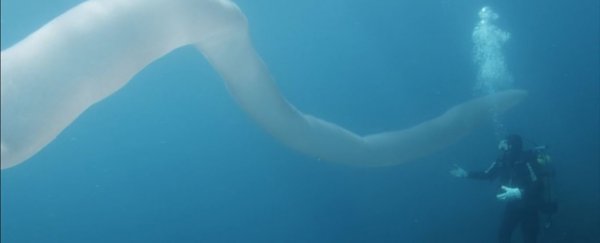From the video, the amorphous blob seems to stretch on for a mile as it snakes through the water, dwarfing the two divers who surround it.
For 48-year-old videographer Steve Hathaway, the October 25 sighting near a small, volcanic island about 30 miles (48 kilometres) off New Zealand's northernmost point put an end to a search that lasted more than a decade.
"I've always wanted to see one," Hathaway said in an interview Wednesday discussing the 26-foot-long (8-metre-long) pyrosome - a colony of tiny sea animals that link together into a free-floating mass.
Their mysterious features and bioluminescent glow have caused some scientists to dub them the "bizarre unicorns of the sea". They reportedly feel "like an exquisitely soft feather boa."
"I was beyond excited. This is like finding something that you've dreamed of for so many years," Hathaway said.
Although they're often described as wormlike creatures, pyrosomes are actually more closely related to humans. Some of the earliest reports of pyrosomes came from sailors in the 1800s who noticed their bright glow while sailing.
Hathaway said he and his friend Andrew Buttle were shooting underwater footage for a promotional video about New Zealand's White Island when they encountered the sea creature.
Buttle's family has owned the island since the 1930s; it contains an active volcano and diverse flora and fauna.
Even though the bulk of his 11-year filming career has taken place underwater - and he's swum with animals such as whales - Hathaway said he'd never encountered a pyrosome of any size until that moment.
When he became aware that one was lying on the ocean floor beneath him, he knew he had to move quickly to film it.
"I've been underwater a lot, and I've seen a lot of animals," he said. "I know nature waits for nobody, and I couldn't let this opportunity pass me by."
Hathaway said springtime on the island brings an abundance of phytoplankton, which pyrosomes feed upon, possibly explaining the reason he encountered one now.
"The fish in general get bigger at White Island than they do in other places in New Zealand," said Hathaway, a lifelong New Zealand resident. "The location is rich in food for animals around the island."
Linsey Sala, a scientist at the Scripps Institution of Oceanography in California, said that while not all pyrosomes grow to be the size of the one Hathaway encountered, some found near New Zealand and Australia can "get quite large," in some cases reaching 45 to 60 feet long.
Pyrosomes are composed of thousands of smaller beings, called zooids, which help the pyrosome feed and navigate the ocean via jet propulsion, Sala said.
Although pyrosome sightings are not necessarily rare, they typically are seen by divers and other people who spend a lot of time in the water.
"I would say it's remarkable and exciting to come across a pyrosome colony that size," Sala said.
Fascinated by the world's oceans as a boy, Hathaway said he would read stories of people embarking on oceanic adventures with a sense of envy and was particularly fascinated by the marlin, which "he used to have dreams about."
He went on to found Young Ocean Explorers, an entertainment and storytelling platform for children that encourages them to love the oceans and marine life.
Hathaway said he hopes catching the pyrosome on video will spark an interest for others, similar to how images of marlins intrigued him as a child.
"It's always been about wanting to go see these things for myself and then sharing them with others," Hathaway said. "Even the most articulate person in the world couldn't describe that creature that we filmed."
2018 © The Washington Post
This article was originally published by The Washington Post.
